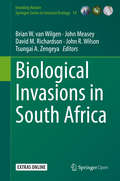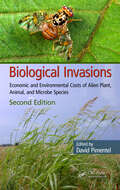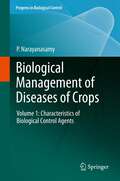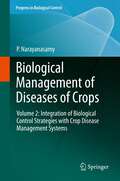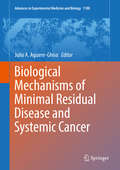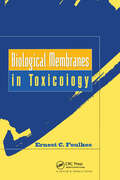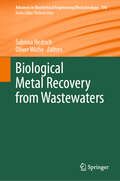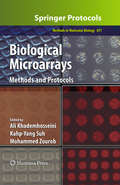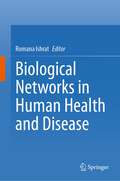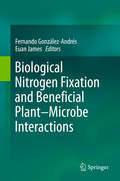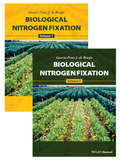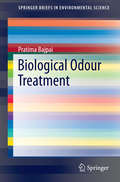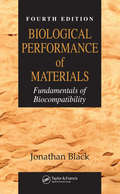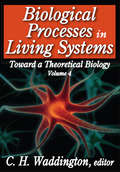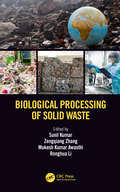- Table View
- List View
Biological Invasions and Its Management in China: Volume 2 (Invading Nature - Springer Series in Invasion Ecology #13)
by Fanghao Wan Mingxing Jiang Aibin ZhanThe book discusses invasive-species problems in agriculture, forests and aquatic ecosystems, highlighting the invasive mechanisms and management of the selected invasive species. Biological invasion has become a serious global ecological and economic problem that deserves particular attention from both government officials and scientists. This volume focuses on three key scientific areas: 1) population establishment and spreading mechanisms of the selected invasive species; 2) ecology adaptation, population growth, expansion and evolution of invasive species; and 3) impact of bio-invasion on the ecosystem structure and function at community and ecosystem levels. The presented research will result in techniques for better management of invasive species. Dr. Fanghao Wan is a professor at the Chinese Academy of Agricultural Sciences Institute of Plant Protection in Beijing, China. Dr. Mingxing Jiang is a professor at Zhejiang University's College of Agriculture and Biotechnology Institute of Insect Sciences in Hangzhou, China. Dr. Aibin Zhan is a researcher at the Center for Eco-Environmental Sciences (RCEES) at the Chinese Academy of Sciences (CAS), Beijing, China.
Biological Invasions in South Africa (Invading Nature - Springer Series in Invasion Ecology #14)
by David M. Richardson John R. Wilson Brian W. van Wilgen John Measey Tsungai A. ZengeyaThis open access volume presents a comprehensive account of all aspects of biological invasions in South Africa, where research has been conducted over more than three decades, and where bold initiatives have been implemented in attempts to control invasions and to reduce their ecological, economic and social effects. It covers a broad range of themes, including history, policy development and implementation, the status of invasions of animals and plants in terrestrial, marine and freshwater environments, the development of a robust ecological theory around biological invasions, the effectiveness of management interventions, and scenarios for the future. The South African situation stands out because of the remarkable diversity of the country, and the wide range of problems encountered in its varied ecosystems, which has resulted in a disproportionate investment into both research and management. The South African experience holds many lessons for other parts of the world, and this book should be of immense value to researchers, students, managers, and policy-makers who deal with biological invasions and ecosystem management and conservation in most other regions.
Biological Invasions in the South American Anthropocene: Global Causes and Local Impacts
by Fabián M. Jaksic Sergio A. CastroThis book provides a conceptually organized framework to understand the phenomenon of biological invasions at the Anthropocene global scale. Most advances toward that aim have been provided from North American and European researchers, with fewer contributions from Australia and South Africa. Here we fill the void from the Neotropics, focusing on the research experience in South American countries, with a strong emphasis on Argentina and Chile. The text is divided into two parts: The first half comprises self-contained chapters, providing a conceptual, bibliographic and empirical foundation in the field of invasion biology, from an Anthropocene perspective. The second half reviews the ecology, biogeography, and local impacts in South America of exotic species groups (European rabbit, Eurasian wild boar, Canadian beaver, North American mink, and Holarctic freshwater fishes), which are shown to be useful models for case studies of global relevance.
Biological Invasions: Economic and Environmental Costs of Alien Plant, Animal, and Microbe Species, Second Edition
by David PimentelThe impact of invasive species is second only to that of human population growth and associated activities as a cause of the loss of biodiversity throughout the world. In the United States, invasions of nonnative plants, animals, or microbes cause major environmental damage. The second edition of Biological Invasions: Economic and Environmental Cos
Biological Magnetic Materials and Applications
by Tadashi Matsunaga Tsuyoshi Tanaka David KisailusThis book addresses the biologically controlled synthesis of magnetic materials, and its applications in bio-inspired design and synthesis. It highlights several key aspects of biologically produced magnetic materials – (i) organisms that biologically synthesize and utilize magnetic materials; (ii) formation mechanisms; (iii) how these biological formation routes yield various phases and morphologies; and (iv) the resultant magnetic and structural properties – and describes diverse bio-inspired approaches to utilizing magnetic materials in applications ranging from semiconductor to health industries.In addition, the book discusses the recent industrial use of magnetic materials to develop scalable technologies that encompass protein displays, drug-delivery, biophysical separations, and medical diagnostics, as well as outlining future next-generation applications. As such, it offers valuable insights for all scientists interested in using multidisciplinary fields to overcome current obstacles, and in gaining multifaceted expertise in magnetic materials bionanotechnology.
Biological Management of Diseases of Crops: Volume 1: Characteristics of Biological Control Agents (Progress in Biological Control #15)
by P. NarayanasamyBiological disease management tactics have emerged as potential alternative to chemical application for containing crop diseases. Biotic and abiotic biological control agents (BCAs) have been demonstrated to be effective against diseases caused by microbial plant pathogens. Combination of biotic and abiotic agents leads to synergism and consequent improvement in the effectiveness of disease control. It is essential to assay the biocontrol potential of all isolates/species of fungal, bacterial and viral biocontrol agents by different techniques in vitro and under greenhouse and field conditions and to precisely identify and differentiate the most effective isolates from less effective ones by employing biological, immunological and nucleic acid-based assays.
Biological Management of Diseases of Crops: Volume 2: Integration of Biological Control Strategies with Crop Disease Management Systems (Progress in Biological Control #16)
by P. NarayanasamyBiological management of diseases of crops is influenced by the nature of interactions between the pathogens and other organisms and the plants. Due to development of resistance in pathogens to fungicides and bactericides, determination of compatibility of biotic biocontrol agents with chemicals is essential for selecting strains of biocontrol agents (BCAs) showing resistance to chemicals to effectively restrict use of the chemicals. Microbial plant pathogens and the antagonists present in the soil and on the plant surfaces are influenced by various cultural practices. It is possible to reduce disease incidence and intensity by crop sanitation and using appropriate rotational crops. Application of physical techniques involving the use of heat, solarization and irradiation has potential to reduce the pathogen population or weaken the potential of pathogens present in the seed, planting materials and soil.
Biological Materials Science
by Marc André Meyers Po-Yu ChenTaking a unique materials science approach, this text introduces students to the basic concepts and applications of materials and biomedical engineering and prepares them for the challenges of the new interdisciplinary field of biomaterials science. Split into three sections - Basic Biology Principles, Biological Materials, and Bioinspired Materials and Biomimetics - it presents biological materials along with the structural and functional classification of biopolymers, bioelastomers, foams, and ceramic composites. More traditional biomimetic designs such as Velcro are then discussed in conjunction with new developments that mimic the structure of biological materials at the molecular level, mixing nanoscale with biomolecular designs. Bioinspired design of materials and structures is also covered. Focused presentations of biomaterials are presented throughout the text in succinct boxes, emphasising biomedical applications, whilst the basic principles of biology are explained, so no prior knowledge is required. The topics are supported by approximately 500 illustrations, solved problems, and end-of-chapter exercises.
Biological Materials of Marine Origin
by Hermann EhrlichThis is the second monograph by the author on biological materials of marine origin. The initial book is dedicated to the biological materials of marine invertebrates. This work is a source of modern knowledge on biomineralization, biomimetics and materials science with respect to marine vertebrates. For the first time in scientific literature the author gives the most coherent analysis of the nature, origin and evolution of biocomposites and biopolymers isolated from and observed in the broad variety of marine vertebrate organisms (fish, reptilian, birds and mammals) and within their unique hierarchically organized structural formations. There is a wealth of new and newly synthesized information, including dozens of previously unpublished images of unique marine creatures including extinct, extant and living taxa and their biocomposite-based structures from nano- to micro - and macroscale. This monograph reviews the most relevant advances in the marine biological materials research field, pointing out several approaches being introduced and explored by distinct modern laboratories.
Biological Materials of Marine Origin: Invertebrates (Biologically-Inspired Systems #1)
by Hermann EhrlichBiological substances appeared in marine environments at the dawn of evolution. At that moment, the ?rst organisms acquired the ability to synthesize polymer chains which were the basis, in their turn, for the formation of the building blocks that fueled the so-called self-assembling process. They, in their turn, produced more complicated structures. The phenomenon of three main organic structural and sc- folding polymers (chitin, cellulose, and collagen) probably determined the further development and evolution of bioorganic structures and, of course, the organisms themselves. Allthethreebiopolymers,notwithstandingtheirdifferencesinchemical composition, have the common principles in their organization: nano?brils with the diameter 1. 5–2 nm, the ability to self-assemble, production of ?brillar and ?ber-like structures with hierarchical organization from nano—up to macrolevels, the ability to perform both the role of scaffolds and the templates for biomineralization and formation of the rigid skeletal structures. Chitin and collagen in particular played the determining role in the formation of skeletal structure in marine invertebrate organisms. These two biopolymers possess all the qualities needed to refer to them simul- neously as biological materials and biomaterials, the latter thanks to their successful application in biomedicine. The fact that modern science ?nds chitin and collagen both in unicellular and in multicellular invertebrates in fossil and modern species con?rms beyond a doubt the success of these biological materials in the evolution of biological species during millions of years. I realize that this success should be consolidated at genetic level and the detection of corresponding conserved genes must be the main priority.
Biological Mechanisms of Minimal Residual Disease and Systemic Cancer (Advances in Experimental Medicine and Biology #1100)
by Julio A. Aguirre-GhisoThis book focuses on the biological mechanisms of minimal residual disease (MRD) and recurrence. It integrates this biology in solid cancers and in hematological malignancies. It reports also on technological advancements for monitoring MRD, derived from mechanistic insights. Chapters in solid and hematological malignancies address stem cell biology, genetics, epigenetics and micro-environmental regulation of dormant MRD. Novel insight into technologies for molecular phenotyping of MRD and monitoring of CTCs, DTCs and cell free RNA and DNA are also addressed extensively. Five chapters explore the above concepts in solid cancers such as prostate, breast, melanoma, head and neck and esophageal. Two chapters also explore the basic mechanisms of vascular biology targeting and epigenetic mechanisms regulating pluripotency programs during dormancy. Similar biology is explored in hematological malignancies such as T-ALL, CML, AML and multiple myeloma in additional four chapters. This book is edited and prefaced by Dr. Julio Aguirre-Ghiso, an expert in dormancy and recurrence. The chapters are written by world-recognized experts Drs. Ravi Bahtia, Samir Parekh, Russel Taichman, Monica Guzman, David Hoon, Denis Schewe, Irmela Jeremias, Cyrus Ghajar, Maria Soledad Sosa and Nicholas Stoecklein. The topic of this book is of particular interest to both basic cancer cell biologists and physician scientists that are working to provide a more integrated view of the biology of MRD and to those interested in working on or learning about this paradigm. The integrated and cross-disciplinary focus of the book from biology to medicine seeks to help bridge gaps to improve cancer care and prevent recurrences.
Biological Membranes in Toxicology
by E. C. FoulkesUsing this concise yet complete introduction to all aspects of biological membranes and their responses to toxicants, the reader will understand the role of cell membranes in controlling uptake, distribution, extrusion and excretion of toxic xenobiotics. The book also covers the historical background and critically evaluates some of the experimenta
Biological Metal Recovery from Wastewaters (Advances in Biochemical Engineering/Biotechnology #190)
by Sabrina Hedrich Oliver WicheThis book reviews the latest research on innovative and sustainable biotechnologies for metal recovery from various process streams, emphasising the fundamentals and applications of biosystems. Divided into 7 chapters, it clarifies many topics including biological iron and aluminum recovery from wastewaters, precious metal recovery (Pt, Pd, Au, Ag), algal-based metal recovery, selenium and tellurium recovery, phytoextraction options, and arsenic removal by sulfate-reducing bacteria. Expert contributors explore microbial metabolisms such as iron oxidation, sulfate/sulfur reduction, and selenite reduction through the lens of environmental sustainability. In this book, readers will discover various case studies and commercial applications of these biotechnologies. Particular attention is given to combinations of biological systems with electrochemistry to enhance metal recycling from complex and diluted streams. This book is a valuable resource for researchers in the field of environmental biotechnology, and scholars of environmental science, chemical engineering and microbiology. Waste management and resource recovery professionals will benefit greatly from the insights provided. This book is a must-read for anyone interested in sustainable solutions for critical metal supply within a circular economy framework.
Biological Microarrays: Methods and Protocols (Methods in Molecular Biology #671)
by Mohammed Zourob Kahp-Yang Suh Ali KhademhosseiniRecent developments in microarray technology have changed the landscape of biology and biomedical research, and they have revolutionized RNA and DNA research. In Biological Microarrays: Methods and Protocols, expert researchers explore exciting new developments in the field, providing a comprehensive approach to biological microarrays that conveys not only the state-of-the-art fundamentals, but also includes applications of the most innovative methods. Chapters address both the application of biological microarrays, including DNA/RNA, apatmer, proteins, tissues, oligonucleotides, carbohydrates, biomaterials, cells, bacteria, and virus microarrays, and also explore the different techniques used for generating microarray platforms. Composed in the highly successful Methods in Molecular BiologyTM series format, each chapter contains a brief introduction, step-by-step methods, a list of necessary materials, and a Notes section which shares tips on troubleshooting and avoiding known pitfalls. Wide-ranging and revolutionary, Biological Microarrays: Methods and Protocols serves as a primary source for academics, practitioners, and professionals in related fields, including biologists, biotechnologists, biochemists, analytical chemists, and biomedical, physical, and microsystems engineers, to name a few, appealing to all of those interested in the present and future state of biological microarray research.
Biological Microtechnique
by Jeremy SandersonA completely new practical guide to both new and classical methods of slide-making which is easy-to-read and easy-to-understand. Biological Microtechnique contains a wealth of practical detail which will provide a firm grounding in preparative methods for light microscopy.
Biological Motion: A History of Life
by Janina WellmannA captivating exploration of the changing definitions of life in biologyBiological Motion studies the foundational relationship between motion and life. To answer the question, &“What is Life?,&” prize-winning historian of science Janina Wellmann engages in a transdisciplinary investigation of motion as the most profound definition of living existence.For decades, information and structure have dominated the historiography of the life sciences with its prevailing focus on DNA structure and function. Now more than ever, motion is a crucial theme of basic biological research. Tracing motion from Aristotle&’s animal soul to molecular motors, and from medical soft robotics to mathematical analysis, Wellmann locates biological motion at the intersection of knowledge domains and scientific and cultural practices. She offers signposts to mark the sites where researchers, technologies, ideas, and practices opened up new paths in the constitution of the phenomenon of motion. An ambitious rethinking of the life sciences, Biological Motion uncovers the secret life of movement and offers a new account of what it means to be alive.
Biological Networks in Human Health and Disease
by Romana IshratThis book presents methods and tools of network biology and bioinformatics for understanding the disease dynamics and identification of drug targets. The initial section of chapters introduce the theoretical aspects followed by the different applications for construction and analysis of biological networks, methods for identifying crucial nodes in networks, and network dynamics. The book covers the latest advances in the network medicine, exploring the different types of biological networks, and their applications. It further reviews the role of R language in the network-based approaches that help in understanding biological systems and identifying biological functions. Towards the end, the book explores the recent developments and applications in machine learning and its potential for advancing network biology. Finally, the book elucidates a comprehensive yet a representative description of challenges associated with the understanding of disease dynamics using network biology. Given its scope, the book is intended for researchers and advanced postgraduate students of bioinformatics, computational biology, and medical sciences.
Biological Nitrogen Fixation and Beneficial Plant-Microbe Interaction
by Fernando González-Andrés Euan JamesThis book covers the most recent advances in all the topics with which researchers and professionals need to be familiar in order to obtain a better understanding of, and to better exploit, beneficial plant-microbe interactions. The use of microorganisms for agriculture and environmental applications is gaining importance worldwide to improve crop performance, but also for other environmental applications, such as bioremediation in chemically polluted soils. The search for an equilibrium between fundamental and applied aspects makes this book useful for professionals at various levels in the value chain of the "microbial biofertilizers". Challenges of comercializing biofertilizers involve efficiency of the products and safety for human health and the environment, topics that have paid central attention in this book. Students, scientists and biofertilizers developers will find updated and comprehensive information about the different aspects to be considered to address a successful introduction of biofertilizers in sustainable agriculture and environmental actions.
Biological Nitrogen Fixation, 2 Volume Set
by Frans J. de BruijnNitrogen is arguably the most important nutrient required by plants. However, the availability of nitrogen is limited in many soils and although the earth's atmosphere consists of 78.1% nitrogen gas (N2) plants are unable to use this form of nitrogen. To compensate , modern agriculture has been highly reliant on industrial nitrogen fertilizers to achieve maximum crop productivity. However, a great deal of fossil fuel is required for the production and delivery of nitrogen fertilizer. Moreover carbon dioxide (CO2) which is released during fossil fuel combustion contributes to the greenhouse effect and run off of nitrate leads to eutrophication of the waterways. Biological nitrogen fixation is an alternative to nitrogen fertilizer. It is carried out by prokaryotes using an enzyme complex called nitrogenase and results in atmospheric N2 being reduced into a form of nitrogen diazotrophic organisms and plants are able to use (ammonia). It is this process and its major players which will be discussed in this book. Biological Nitrogen Fixation is a comprehensive two volume work bringing together both review and original research articles on key topics in nitrogen fixation. Chapters across both volumes emphasize molecular techniques and advanced biochemical analysis approaches applicable to various aspects of biological nitrogen fixation. Volume 1 explores the chemistry and biochemistry of nitrogenases, nif gene regulation, the taxonomy, evolution, and genomics of nitrogen fixing organisms, as well as their physiology and metabolism. Volume 2 covers the symbiotic interaction of nitrogen fixing organisms with their host plants, including nodulation and symbiotic nitrogen fixation, plant and microbial "omics", cyanobacteria, diazotrophs and non-legumes, field studies and inoculum preparation, as well as nitrogen fixation and cereals. Covering the full breadth of current nitrogen fixation research and expanding it towards future advances in the field, Biological Nitrogen Fixation will be a one-stop reference for microbial ecologists and environmental microbiologists as well as plant and agricultural researchers working on crop sustainability.
Biological Oceanography
by Eric MillsFirst published in 1989, Eric L. Mills's comprehensive history of biological oceanography has been praised as 'superb' (BioScience) and 'proof that history need not be dull' (The Northern Mariner). This first history of the field, which chronicles the scientific work and creativity of its chief contributors, tells a riveting story that is far from narrowly scientific and thoroughly accessible to general readers. Mills shows how the work and ideas of the main actors are inseparable from some seemingly unrelated factors, including Prussian imperialism, agricultural chemistry, microbiology, and the problems of German universities. Mills also illustrates the significant roles played in the field's development by the failures of commercial fisheries, the development of analytical chemistry, the establishment of international scientific organizations, and sheer scientific curiosity.This new edition of Biological Oceanography includes a fresh introduction by the author, as well as an original foreword by noted oceanographer John Cullen. It makes an excellent companion to Mills's recent history of mathematical and physical oceanography, the multi-award-winning and widely acclaimed The Fluid Envelope of Our Planet.
Biological Odour Treatment (SpringerBriefs in Environmental Science)
by Pratima BajpaiShowcasing the very latest technologies for neutralising the unpleasant--and sometimes dangerous--odours from industrial and waste management processes, this Springer Brief in Environmental Sciences covers physical, chemical and biological methods. The volume includes modern biotechnological approaches now making it cost-effective to tackle malodorous chemicals at very small concentrations. The book reflects the fact that odour affects us in several ways, which range from compromising our quality of life to causing respiratory and other unpleasant conditions and from depressing property values to severe health problems caused by the toxic stimulants of odours. Innumerable industrial processes release malodourous and harmful vapours. The human sense of smell can detect some noxious chemicals, such as the sulphurous by-products of paper manufacturing, at concentrations of one part per billion. This e-book shows what has been achieved in combating offensive and harmful odours. While conventional air pollution control technologies can treat a wide variety of pollutants at higher concentrations, the chapters cover the more refined biological methods used to deal with odours and volatile organic compounds in low concentrations. These include bio scrubbers and bio trickling filters. Standing alongside its detailed discussion of the health impacts of total reduced sulphur compounds, and the composition of paper pulp industry emissions, this publication offers comprehensive and in-depth treatment of some of the most potent anti-odour technologies yet devised.
Biological Outlook to Improve the Nutritive Quality of Bakery Products
by Nitin Kumar Singh Sanket J. Joshi Gaurav Sanghvi Ashok Kumar BishoyiThis book aims to bring the focus on biological viewpoint and alternatives for producing the baked goods, as the confectionary is a major market segment comprising of the sugar and baked products. The bakery products include major segments including cereals, bread, chocolates, cookies, and other confectionary items. This book provides the data regarding the market of baked goods, as it is forecasted to increase at growth rate of 5.8% (CAGR) and it’s expected to reach around its growth around (7%) by 2025 (Fortune insights 2022). The book also classifies amongst the major consumers worldwide, Asia pacific contributes around 43%, western Europe contributes around 22% while Africa continent represents as smallest group of consumers for baked confectionary consumers. The book provides information regarding health concerns as baked goods are liked by population of all ages. As per the data mentioned above the bakery goods are consumed heavily without clear insights about its health concerns. Majority of baked goods are made up of all-purpose flour having serious risk concerns/impact on health and higher consumption of bakery goods can increase sugar, cholesterol level and can also cause further problem in liver or heart functions. Although, gluten free, multigrain baked confectionaries are now a day’s available in the market but the still the better understanding of the bio-based products is need of current time. The biological viewpoint especially for the bakery goods can serve as initial point for better handling baked goods in context of upbringing of healthy society. The book targets students and researchers interested in interdisciplinary research and devising novel biological applications with special focus on bakery products.
Biological Performance of Materials: Fundamentals of Biocompatibility, Fourth Edition
by Jonathan BlackBioengineers need a thorough grounding in biocompatibility - the biological performance of materials. Until now, there were no publications suitable for a neophyte in the field; prior publications were either not comprehensive or focused on rather narrow interests. Drawing on the author's 35 years of experience as a teacher, researcher, and consult
Biological Processes in Living Systems: Toward A Theoretical Biology (Toward a Theoretical Biology)
by C. H. WaddingtonBiological Processes in Living Systems is the fourth and final volume of the Toward a Theoretical Biology series. It contains essays that deal in detail with particular biological processes: morphogenesis of pattern, the development of neuronal networks, evolutionary processes, and others. The main thrust of this volume brings relevance to the general underlying nature of living systems. Faced with trying to understand how the complexity of molecular microstates leads to the relative simplicity of phenome structures, Waddington-on behalf of his colleagues-stresses on the structure of language as a paradigm for a theory of general biology. This is language in an imperative mood: a set of symbols, organized by some form of generative grammar, making possible the conveyance of commands for action to produce effects on the surroundings of the emitting and the receiving entities. "Biology," he writes, "is concerned with algorithm and program." Among the contributions in this volume are: "The Riemann-Hugoniot Catastrophe and van der Waals Equation," David H. Fowler; "Differential Equations for the Heartbeat and Nerve Impulse," E. Christopher Zeeman; "Structuralism and Biology," Rene Thom; "The Concept of Positional Information and Pattern Formation," Lewis Wolpert; "Pattern Formation in Fibroblast Cultures," Tom Elsdale; "Form and Information," C. H. Waddington; "Organizational Principles for Theoretical Neurophysiology," Michael A. Arbib; "Stochastic Models of Neuroelectric Activity," Jack D. Cowan. Biological Processes in Living Systems is a pioneering volume by recognized leaders in an ever-growing field.
Biological Processing of Solid Waste
by Sunil Kumar, Zengqiang Zhang, Mukesh Kumar Awasthi, and Ronghua LiOffering a comprehensive approach, this title covers fundamentals, technologies, and management of biological processing of solid waste. It discusses kinetic modeling and synergistic impact evolution during bioprocessing of solid waste, environmental impacts such as greenhouse gas emission from biological processing of solid waste, energy recovery from solid waste, and biodrying of solid waste. It also presents cases and challenges from different countries, successful business models, and economic analyses of various processing options. Aimed at researchers and industry professionals in solid and hazardous waste management, this title offers a wealth of knowledge to help readers understand this increasingly important area.

